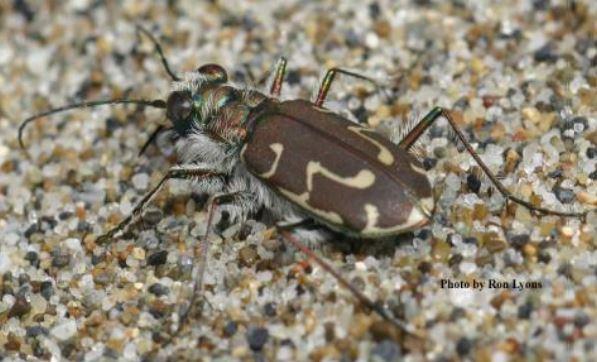Moderate-
High
In Washington, the Siuslaw sand tiger beetle is designated as a "Species of Greatest Conservation Need" due to their small number of isolated populations, highly limited distribution and range, and dependence on specialized, restricted and threatened habitats.
Description and Range
Physical description
The Siuslaw sand tiger beetle is in the family Carabidae and subfamily Cicindelinae. This beetle's length ranges from about 1/4 to about 1/2 inch. They have a bulkier body and shorter legs than other tiger beetles. They are brown to reddish brown in color with thin, light tan, hook-shaped markings on their wing casings. Like other C. hirticollis subspecies, the sides of their thoraxes have long, white hairs, which is why these beetles are called "hairy-necked."
Ecology and life history
The Siuslaw sand tiger beetle is a habitat specialist. It Inhabits a narrow ecological niche: unvegetated sands at the edge of freshwater outflows on Pacific Coast beaches. A study of this species’ habitat in Oregon found adult beetles using firm, flat, moist sand at and near the freshwater edge, including areas upstream of the river mouth and along backwater lagoons and wetlands; and the sloping edge of dryer dunes just above the river’s high water mark.
Carabids undergo complete metamorphosis, which means they have egg, larval, pupal, and adult life stages. These beetles typically reproduce annually; adults can live for several years, and larvae may require multiple years for complete development.
Females create shallow burrows in the soil with their ovipositor, where they lay eggs singly; larvae feed and develop, pupation occurs, and adults emerge from these tunnel-like burrows. Thus, soil condition, including texture, moisture, and temperature is a vital element of habitat quality.
Carabids are key predators of the insect world; as both larvae and adults they feed on other insects and, to a lesser extent, plant material. Adults hunt by sight and are fast runners that can quickly subdue their prey. Siuslaw sand tiger beetle adults generally forage during the day, and at night burrow into soil, sand, or other substrate.
Adults tiger beetles can fly, but these species are highly localized and sedentary. They inhabit their sites year-round (as egg, larva, pupa and adult).
Geographic range
In Washington, the overall range of the Siuslaw sand tiger beetle are coastal beaches in southwest Washington (Pacific County) south to northern California; however, recent detections have been in Oregon only.
Carabid beetles have restricted ranges and distributions within Washington. Distribution is limited in part by a combination of their dependence on restricted ecological niches, and those niches’ location within rare habitat types. Their distribution and abundance is characterized by small numbers of isolated populations.
Surveys are needed to determine the distribution of the Siuslaw sand tiger beetle and locate any extant Washington populations. Population sizes have not been determined for this species on any site.
For a map showing range-wide conservation status and distribution, see NatureServe Explorer.
Climate vulnerability
Sensitivity to climate change
Moderate
Siuslaw sand tiger beetles occupy sandy beaches at the interface of river mouths and the Pacific Ocean. This species is likely sensitive to drought, reduced streamflow, and increasingly xeric conditions, as larvae have narrow moisture requirements and burrows are located adjacent to surface water or in areas with persistent soil moisture.
Exposure to climate change
Moderate-
High
- Reduced stream flow
- Drought and/or reduced soil moisture
Conservation
Conservation Threats and Actions Needed
- Invasive and other problematic species
- Threat: Invasive plants, those currently here, and many yet to come in the future, establish in habitat and stabilize soil, thereby making habitat unsuitable for this beetle.
- Action Needed: Using herbicide and mechanical methods to maintain open ground and appropriate soil condition.
- Resource information collection needs
- Threat: Need to determine where extant in Washington.
- Action Needed: Revisit historic locales and search for new populations.
See the Climate vulnerability section for information about the threats posed by climate change to the Siuslaw sand tiger beetle.
Resources
References
Mazzacano, C., S. Jepsen, and S. Hoffman-Black. 2010. Surveys to determine the status of two rare insect species on the Oregon coats: the Siuslaw hairy-necked tiger beetle (Coleoptera: Cicindelidae: Cicindela hirticollis siuslawensis Graves, Krejci, and Graves, 1988) and the Oregon plant bug (Hemiptera: Miridae: Lygus oregonae Knight, 1944). Project completion report submitted to the Interagency Special Status/Sensitive Species Program (ISSSP), US Bureau of Land Management and US Forest Service. 26pp.
USFS-BLM. 2007. Species fact sheet: Siuslaw Sand tiger beetle. Prepared by The Xerces Society for Invertebrate Conservation. Portland, Oregon.
